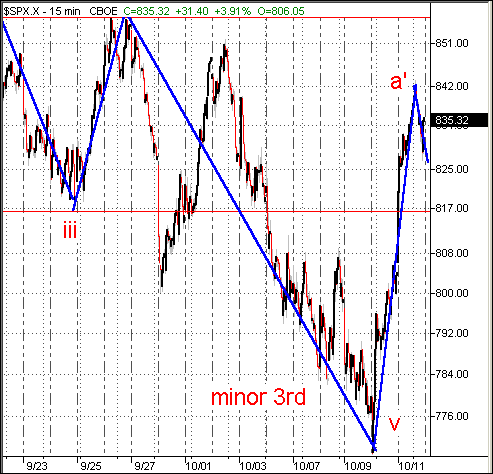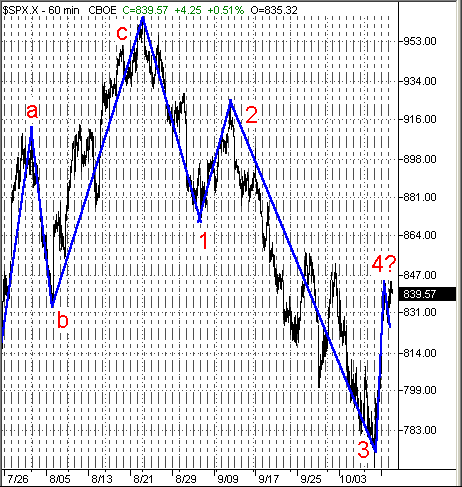
HOT TOPICS LIST
- MACD
- Fibonacci
- RSI
- Gann
- ADXR
- Stochastics
- Volume
- Triangles
- Futures
- Cycles
- Volatility
- ZIGZAG
- MESA
- Retracement
- Aroon
INDICATORS LIST
LIST OF TOPICS
PRINT THIS ARTICLE
by David Penn
A minute fifth bottom sets the stage for a bullish, a-b-c correction in October.
Position: N/A
David Penn
Technical Writer for Technical Analysis of STOCKS & COMMODITIES magazine, Working-Money.com, and Traders.com Advantage.
PRINT THIS ARTICLE
ELLIOTT WAVE
Elliott Wave: Extensions and Retracements
10/14/02 01:40:08 PMby David Penn
A minute fifth bottom sets the stage for a bullish, a-b-c correction in October.
Position: N/A
| At times, as I study Elliott Wave analysis, I feel a bit like the character Private Joker from the war movie, Full Metal Jacket: "This is my wave count. There are many like it, but this one is mine." Nevertheless, I think a compelling argument can be made that the powerful two-day rally on October 10th and 11th represented the end of a minor third wave that began on September 11th. Since that time, the S&P 500 has lost just over 150 points, or 16.5%. While the October 10-11 rally took many by surprise, it is increasingly clear that the rally came as a result of the third wave finally putting in a bottom after a pair of extensions--a large extension in late September and a smaller one in the first week of October. While Elliott Wave practioners have taken quite a bit of guff from critics over the theory/subject of wave extensions, there is ample writing from R.N. Elliott himself to A.J. Frost and Bob Prechter discussing not only what extensions in waves are, but also what analysts can learn from them. These authors are most explicit with regard to extensions in fifth waves, postulating that the a-b-c retracement that follows a fifth wave that has featured extensions will find support (or resistance, in the case of bullish a-b-c) at the low (or high) of the previous extension. |
| Here, the extensions are in the fifth minute wave, which means we should be on the lookout for the current minute wave a' to run into resistance somewhere in the neighborhood of the October 2nd highs. This is also classic, support and resistance technical analysis, in which previous highs serves as resistance until breached by subsequent rallies. However, Elliott Wave theory puts a particular spin on this resistance. As Prechter notes in Elliott Wave Principle, "the most important empirically derived rule that can be distilled from (Elliott's) comments is that when an extension occurs in a fifth up-wave, the ensuing correction will occur in three waves and retrace to the level of the beginning of the extension ..." |

|
| Figure 1: A minor third wave bottom coincides with a minute fifth wave bottom. |
| Graphic provided by: TradeStation. |
| |
| Much writing about EW deals disproportionately with bull markets, so some inversion is occasionally necessary when the prevailing trend becomes bearish (such as in the wake of a major Cycle and SuperCycle top as in 2000). As such, we are concerned about extensions in a fifth DOWN wave, and are looking to see whether the ensuing three-wave correction will retrace to the point where the extension begins on the downside, or the peak on October 2nd. Prechter suggests further that the first retracement will be "followed by a second retracement wave which carries into new high ground for the cycle. That is, fifth wave extensions are always double retraced. The second retracement marks either the beginning of the next impulse wave of larger degree, or, if the previous wave of one larger degree was a fifth itself and a major reversal is due, the first and second retracements will become waves A and B of an irregular correction ..." |
| I am not convinced the current minute a'-b'-c' correction that is also a minor fourth falls into either of the above categories--particularly as it relates to Prechter's note about wave B. As we will see, there is grounds for seeing the minute c' wave as the beginning of a minor fifth. In the context of the minute waves in the S&P 500 in October (and assuming my assessment of the first retracement is correct) Prechter's point can be interpreted to mean that the second retracement wave in October will likely take the S&P 500 down to new LOW ground for the cycle. Additionally, it appears that the a-b-c correction will likely represent the minor fourth wave, as suggested above. When Prechter refers to the second retracement as marking the beginning of the next impulse wave of larger degree, it appears that he is refering to the minute b' wave that is in the same direction as the prevailing trend. I use the term "prevailing trend" here, instead of "impulse" because, once the prevailing trend becomes bearish, it is downward movement that is divided into five "impulse"-like waves and upward, countertrend movement that is divided into three "corrective"-like waves. By referring to the prevailing trend in this instance, I think it is easier to apply Elliott Wave to bear markets. |
 Figure 2: The minute a'-b'-c' correction appears to be part of a countertrend, minor fourth wave. What this seems to suggest is that there will be a minute a' wave that, beginning on October 10th, will test the October highs from the beginning of the month. There should then be a minute b' wave that takes the S&P 500 into "new ground" for the cycle. In the current context, this can only signify a move to the downside and, by "new ground" one must wonder whether or not the lows of October 9th will be breached by a declining minute b' wave. I confess to finding it difficult to see a minute b' wave taking the S&P 500 beneath the October 9th lows, and will wait for the resolution of the current minute a'-b'-c' before trying again to interpret Prechter on the matter of the "second retracement." Finally, I would expect a minute c' wave that would complete the countertrend, minor fourth wave to the upside and set the stage for a minor fifth back downward--a minor fifth, incidentally, that will have a bottom that will coincide with what will likely be an intermediate third bottom. |
Technical Writer for Technical Analysis of STOCKS & COMMODITIES magazine, Working-Money.com, and Traders.com Advantage.
| Title: | Technical Writer |
| Company: | Technical Analysis, Inc. |
| Address: | 4757 California Avenue SW |
| Seattle, WA 98116 | |
| Phone # for sales: | 206 938 0570 |
| Fax: | 206 938 1307 |
| Website: | www.Traders.com |
| E-mail address: | DPenn@traders.com |
Traders' Resource Links | |
| Charting the Stock Market: The Wyckoff Method -- Books | |
| Working-Money.com -- Online Trading Services | |
| Traders.com Advantage -- Online Trading Services | |
| Technical Analysis of Stocks & Commodities -- Publications and Newsletters | |
| Working Money, at Working-Money.com -- Publications and Newsletters | |
| Traders.com Advantage -- Publications and Newsletters | |
| Professional Traders Starter Kit -- Software | |
Click here for more information about our publications!
Comments
Date: 10/16/02Rank: 5Comment:

|

Request Information From Our Sponsors
- StockCharts.com, Inc.
- Candle Patterns
- Candlestick Charting Explained
- Intermarket Technical Analysis
- John Murphy on Chart Analysis
- John Murphy's Chart Pattern Recognition
- John Murphy's Market Message
- MurphyExplainsMarketAnalysis-Intermarket Analysis
- MurphyExplainsMarketAnalysis-Visual Analysis
- StockCharts.com
- Technical Analysis of the Financial Markets
- The Visual Investor
- VectorVest, Inc.
- Executive Premier Workshop
- One-Day Options Course
- OptionsPro
- Retirement Income Workshop
- Sure-Fire Trading Systems (VectorVest, Inc.)
- Trading as a Business Workshop
- VectorVest 7 EOD
- VectorVest 7 RealTime/IntraDay
- VectorVest AutoTester
- VectorVest Educational Services
- VectorVest OnLine
- VectorVest Options Analyzer
- VectorVest ProGraphics v6.0
- VectorVest ProTrader 7
- VectorVest RealTime Derby Tool
- VectorVest Simulator
- VectorVest Variator
- VectorVest Watchdog
